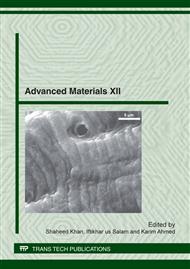p.80
p.89
p.98
p.105
p.111
p.118
p.124
p.132
p.137
Effect of Ageing on Mechanical and Shape Memory Properties of Ti-5Cr-4Ag Alloy
Abstract:
The effect of ageing on mechanical, shape memory and pseudoelastic properties of our recently developed Ti-5Cr-4Ag alloy was investigated for biomedical and engineering applications. The results are summarized as follows. (A) Solution-treated alloy exhibited ductile behavior (13% fracture strain), shape memory properties (57% shape recovery) and pseudoelastic response. (B) Ageing at 573K and 973K for 3.6ks has resulted into improvements of UTS and yield stress. However the fracture strain, shape recovery ratio and pseudoelastic response were decreased due to precipitation of α (hcp) phase and stabilization of remaining β (bcc) phase. (C) Ag addition suppressed ω (hexagonal) phase precipitation as ω phase could not be detected for solution-treated and aged conditions. It is concluded that Ti-5Cr-4Ag in solution-treated and 973K aged conditions has potential for biomedical and engineering applications due to good strength-ductility correspondence, shape memory and pseudoelastic properties and suppression of ω phase precipitation.
Info:
Periodical:
Pages:
111-117
Citation:
Online since:
May 2012
Authors:
Keywords:
Price:
Сopyright:
© 2012 Trans Tech Publications Ltd. All Rights Reserved
Share:
Citation:


